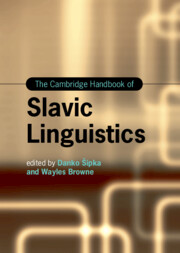Book contents
- The Cambridge Handbook of Slavic Linguistics
- Cambridge Handbooks in Language and Linguistics
- The Cambridge Handbook of Slavic Linguistics
- Copyright page
- Contents
- Figures
- Tables
- Contributors
- Introduction
- Part 1 Prosody and Phonology
- 1 Word Stress
- 2 Vocalism: The Vowels
- 3 Consonantism: The Consonants
- 4 Syllable Structure
- 5 Phonologically Conditioned Alternations
- 6 Prosodic Reflexes of Information Structure
- Part 2 Inflectional and Derivational Morphology
- Part 3 Syntax
- Part 4 Lexicon
- Part 5 Sociolinguistic and Geographical Approaches
- Part 6 Experimental and Quantitative Approaches
- Name Index
- Subject Index
- References
6 - Prosodic Reflexes of Information Structure
from Part 1 - Prosody and Phonology
Published online by Cambridge University Press: 16 May 2024
- The Cambridge Handbook of Slavic Linguistics
- Cambridge Handbooks in Language and Linguistics
- The Cambridge Handbook of Slavic Linguistics
- Copyright page
- Contents
- Figures
- Tables
- Contributors
- Introduction
- Part 1 Prosody and Phonology
- 1 Word Stress
- 2 Vocalism: The Vowels
- 3 Consonantism: The Consonants
- 4 Syllable Structure
- 5 Phonologically Conditioned Alternations
- 6 Prosodic Reflexes of Information Structure
- Part 2 Inflectional and Derivational Morphology
- Part 3 Syntax
- Part 4 Lexicon
- Part 5 Sociolinguistic and Geographical Approaches
- Part 6 Experimental and Quantitative Approaches
- Name Index
- Subject Index
- References
Summary
The author first defines the following notions of information structure: focus (vs. background), given (vs. new), and topic (vs. comment). He then goes on to show how these notions are reflected in the prosodic systems of Slavic languages. Focus in all Slavic languages is reflected in prosodic prominence governed by a stress-focus correspondence defined by the author. In general, ‘given’ is realized outside the sentence stress. Focus does not have an obligatory prosodic reflex in Slavic languages.
- Type
- Chapter
- Information
- The Cambridge Handbook of Slavic Linguistics , pp. 104 - 126Publisher: Cambridge University PressPrint publication year: 2024

